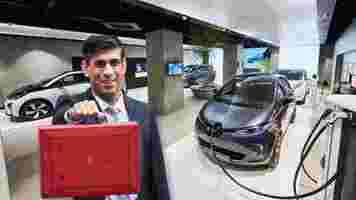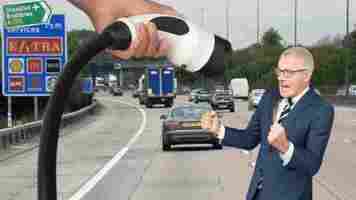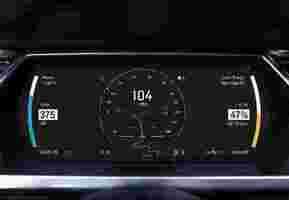EVs will get hit by new taxes, and I’m not sure what we can do about it
Despite upfront costs, owning and running an electric vehicle is quite often cheaper than an equivalent gasoline vehicle. For owners, this is undeniably good news. But governments around the world are losing tax money.

According to research from The Sunday Times Driving , the UK government is losing £1,000 in fuel duty and emissions-based taxes in the first year when someone switches to an EV.
This isn’t surprising when we consider that more than 50% of petrol’s cost is duty and tax. As soon as demand for petrol and diesel falls, the government’s purse strings tighten.
The report says that when a petrol driver switches to an EV, they save an average of £592 a year in excise and VAT, and £305 in the emissions-based showroom tax. Diesel drivers save even more when they make the switch, saving £800 a year in fuel duty, and £338 in other taxes.
In the short term, it’s combustion engine drivers that will be hit hardest financially, as increases in fuel duty are implemented in March. With government incentives on EVs still being offered, and the upfront costs of ownership still too high for the majority, it seems wealthier drivers better placed to make the switch to electric power stand to be least affected.
In the long term, it seems that electric vehicles will lose some of their allure as new charges are introduced to make up for shortfalls.
One of the most talked about possibilities is the introduction of road tolls, charging drivers to use roads. This money could then be funneled back into improving infrastructure specifically for electric vehicles. If that’s the case, it doesn’t seem so bad as EV drivers would eventually see the benefit of the payment.
If combustion engine cars are charged to use to the roads, it would also serve as another reason to ditch gasoline. In these cases gasoline drivers would be paying fuel duty, emissions taxes, and road tolls.
But it all hinges on how and when road tolls are introduced.
If they’re brought in too soon, buying an EV could become a far less enticing option, financially speaking. It might dissuade many from making the switch.
With the country set to ban the sale of new gasoline vehicles in the next decade, it’s not going to send a good message if EVs all of a sudden get more expensive to run when governments have often touted them as the being better value for money long-term than combustion engine cars.
Last year, Denmark suggested that the switch to electric vehicles could cost its welfare system $904 million , as it loses money from fuel and vehicle taxes.
While stories like these are concerning for the future cost of driving an EV, it points to a larger problem.
We’ve become so reliant on fuel that it’s become a linchpin of government funding and our dependency on it has been exploited.
One thing is for sure, governments will have to find new money spinners as we become far less reliant on petrol and diesel. While the upfront costs of buying an EV will come down with adoption, driving them could become far more expensive.
As EVs become the norm, new taxes seem unavoidable.
SHIFT is brought to you by Polestar. It’s time to accelerate the shift to sustainable mobility. That is why Polestar combines electric driving with cutting-edge design and thrilling performance. Find out how .
Meet the company mapping European cities to solve escooter misparking
This article was originally published by Steve Schaefer on Clean Fleet Report , a publication that gives its readers the information they need to move to cars and trucks with best fuel economy, including electric cars, fuel cells, plug-in hybrids, hybrids and advanced diesel and gasoline engines.

Micromobility — including electric scooters — is the latest quick and clean way to get around urban areas. But one big problem is managing where the fleets of shared scooters go and where they’re parked. Fantasmo has a solution — camera vision-based positioning. Fantasmo enables it by first mapping cities at the ground level, and then scooter riders use the camera on their phone to accurately record their exact position when it comes time to park.
When the first scooter fleets started operating in Santa Monica, California, riders took an end-of-ride photo that roughly placed their location. GPS was used to create a geofence in the city to say, keep scooters out of parks, but was not very accurate. When other cities started having scooter fleets, their biggest issues were bad parking and clutter, and sidewalk riding. GPS mapping was too blunt of an instrument to monitor it effectively. Now, cities like San Francisco and Chicago simply require e-scooters to be locked to posts or signs to keep them out of the walkway.
Fantasmo’s technology solves this issue by providing the granularity to make accurate tracking of scooter parking possible. It will also come in handy for future applications, such as tracking delivery bots and use by the visually impaired.
Mapping the key cities
Fantasmo is a seven-year-old US-based startup that’s backed by investors including Unlock Venture Partners, Freestyle Capital, TenOneTen Ventures, and LDV capital, among others.
The company recently partnered with major European micromobility operator TIER to map more than 85 cities through exclusive partnerships in Europe and the UK, including Paris, France, and York, England.
I spoke with Jameson Detweiler, co-founder and president of Fantasmo, about his company and the software and hardware that make this possible. Educated at Drexel University in Material Science and Engineering, Jameson also has plenty of startup and leadership experience. He previously co-founded LaunchRock, an idea-launching product, was founder and CEO of GreenKonnect, a human-powered search engine for the green building industry, and he co-founded LED lighting startup Summalux.
Fantasmo began as Fantasmo Studios. They were looking for the technology to create augmented reality games like Pokemon Go, which superimpose the game onto your actual surroundings. But it soon grew into much more.
“We wanted to combine alternate reality games with machines to better understand the real world and how to assist humans,” said Jameson. “We decided to focus on the next generation of mapping technology.”
Building a map from the ground up
Positioning from satellites (GPS) is used by many applications, but the problem in cities is that buildings, trees, and other objects can block the view of the street. This causes inaccuracies when the signal bounces off of these objects. Fantasmo’s solution is to build a 3D map of cities at the ground level, collected using cameras and sensors similar to those found on EVs. Once a city is mapped, Fantasmo can determine someone or something’s position by pinning camera footage to that digital map using its Camera Positioning System (CPS)—an alternative to GPS.
“We can create a visual fingerprint from the surroundings, like a big QR code, and use advanced math to interpolate from the images,” said Jameson.
Fantasmo maps a city using the 22-pound Fantasmo Explorer backpack, which a Fantasmo employee wears as they walk down the sidewalks of the target city.
Fantasmo recently mapped 1,800 kilometers (1,118 miles) of Paris by foot, and is now working in York, with more cities on the way (under the TIER partnership). By taking the images from the sidewalk, it can target exactly where the scooters are at the end of a ride, when the rider uses their camera to take a few seconds of video images of the surrounding buildings.
The Paris project employed six backpacks, each shared by two people working shifts for a few weeks. The French capital enjoys high scooter usage, but limited sidewalk space, so it has designated 2,500 mandatory parking corrals for them. Fantasmo mapped these areas first and will eventually map the entire city.
The high-tech backpacks are set up with shoulder and waist straps, like good backpacking gear. They bristle with two lidar “pucks” and six cameras, like the ones used on autonomous vehicles, and are a little like micro-sized, wearable Google mapping cars. After a couple of hours of training, the employees follow their assigned missions for the day, using iPads to communicate with the backpacks.
Now, when a French scooter rider is ending their ride, they will use the TIER app to scan the surroundings for a few seconds and the app tells them if they are in a designated parking area, to an accuracy of 20 cm (just under eight inches). If they are not, then they must move to one before they can end their ride. No physical infrastructure is needed.
Fantasmo manages the entire mapping project for a city for TIER or any other client. This means that they visit the target city and use their mission planning tool to draw the boundaries and create walking routes to cover the whole city. Once those routes are queued up, they can be assigned to the walkers. Fantasmo’s system monitors progress and can fill in any gaps that may occur.
Naturally, there are changes in a city over time, but the software can flag changes when riders use it, so new images can be taken, say, if a building is torn down. However, the initial backpack mapping creates a “substrate layer” that doesn’t need much updating. The images use solid, permanent items like a building’s windowsills, so changes in signage, for example, don’t affect the accuracy.
“It’s a dynamic situation,” said Jameson. “We recently had to skip mapping a section in York because it was flooded,” said Jameson.
Jameson sees the future in self-healing maps, and the use of data from more sources.
“For the next generation, any device can take images, masking out personal data, and create a digital twin of a city,” said Jameson. “This will be good for autonomous solutions for micromobility, pedestrians, and cars.“
He also sees a time when the technology will live on the scooters themselves.
“We’ll know where the scooter is 100 percent of the time,” said Jameson. The scooters will be as smart as robots.”
Jameson believes that accurate positioning is a steppingstone to real autonomy in cities. Every device will be aware of itself, its location, and other vehicles, scooters, bikes, and people. Thanks to the shared mapping, it will be able to “see-through buildings.” The goal is zero accidents and maximum efficiency. Fantasmo’s applications also work with mobile, auto, and robotics, so there are lots of exciting things coming.
When will the company come home and start mapping American cities? There are plans, and Fantasmo will announce them when it’s time.
Autonomy and micromobility are essential to the health of our cities, and Fantasmo’s mapping technology is in the middle of it, making it happen. SHIFT is brought to you by Polestar. It’s time to accelerate the shift to sustainable mobility. That is why Polestar combines electric driving with cutting-edge design and thrilling performance. Find out how .
3 EV economy metrics you need to know
Welcome to SHIFT Basics , a collection of tips, explainers, guides, and advice to keep you up to speed with mobility tech.

Humans have measured the efficiency of gasoline cars using miles per gallon (MPG) and liters per 100 kilometers (L/100km), for as long as anyone that’s alive can remember.
Both these figures offer drivers a quick and understandable number that represents the efficiency of their vehicle. For MPG a higher number is better, and with L/100km a lower number is better. The more you drive and pay attention to these figures, the more you’ll understand what kind of efficiency your vehicle is capable of.
But what about electric vehicles? What numbers do we need to know about to understand their efficiency?
When it comes to EVs, we have a few metrics comparable to the above, MPGe, kWh/100km, and M/kWh. Let’s take a look at what the mean.
kWh/100km
First off, let’s start with what kWh/100km. This stands for kilowatt-hours per 100 kilometers.
Put simply, this is a measure of how much battery power is used to drive 100km. It’s not a retrospective number though, EVs will display this figure on the dashboard as an indicator of real-time efficiency.
Looking at typical EV range tests , anywhere between 13 and 20 kWh/100km can be considered pretty normal. Smaller and lighter EVs tend to come in at the lower end of this range, whilst bigger and heavier EVs tend to come in closer to the top.
Some cars present this figure in watt hours per km (Wh/km), which is just a slightly smaller denomination of the above, but it means the exact same thing.


If you’re in pursuit of efficiency you want this number to be as low as possible.
Kilowatt-hours (kWh) is a measure of how stored energy, think of it like a volume of gasoline that gets burned every 100km driven. When you’re burning less, you’re driving more efficiently.
MPGe
Miler per gallon equivalent, or MPGe, is a little more complicated, but is useful when you’re comparing an EV’s energy efficiency to an old-fashioned gasoline vehicle.
Some clever scientists managed to calculate how much energy is contained within a gallon of gasoline, and from that — using some complex mathematics — can indicate how efficient they are.
Those boffins found that one gallon of gas contains the equivalent to 33.7 kWh of electrical power. By considering how far an EV can travel on that amount of electricity, we can calculate a miles per gallon figure that is equivalent to if it was a gasoline vehicle.
This is a useful figure when you’re buying a new car, and are considering both EVs and gasoline vehicles, but most EV drivers seem to prefer kWh/100km for measuring efficiency in real time. Most EV reviewers quote the per 100km figure when discussing efficiency rather than MPGe.
Miles per kWh
Another measure of electrical economy in an EV is the miles per kWh, or M/kWh, measure. In countries where kilometers are the main unit of measure, this could also be km/kWh.
If you ask me, this is more useful than a MPGe figure in the real world. When you drive an EV, you can get a real-time read out of how many miles you drive per kWh. If you know how much charge your battery had in kWh before you set off, how long your journey is, and the typical M/kWh your vehicle maintains, you’ll be able to calculate if you’ll make it to your destination without needing to charge.
While cruising on the highway, you can expect an EV to travel anywhere between three and six miles per kWh. If you’re using this metric to monitor the efficiency of your vehicle, you obviously want the number to be higher, because like with MPG, it means you’re traveling further for every unit of energy expended.
There you have it, next time you’re trying to figure out just how to measure your EV’s efficiency in the real world, you’ve got at least three metrics to use.
If you’re aiming to drive as efficiently as possible, only some variables are in your control. Your vehicle’s weight, aerodynamics, and drivetrain affect how efficient it is. However, as the driver you can control tire pressure, how hard you accelerate, and how fast you drive — all of which affect efficiency.
If you’re wanting to convert measures between these metrics, here’s a handy calculator .
SHIFT is brought to you by Polestar. It’s time to accelerate the shift to sustainable mobility. That is why Polestar combines electric driving with cutting-edge design and thrilling performance. Find out how .